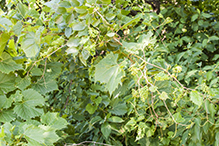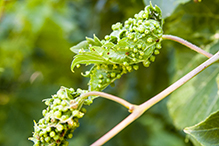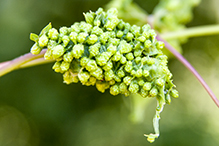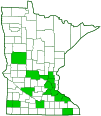Grape phylloxera
(Daktulosphaira vitifoliae)
Conservation • Description • Habitat • Ecology • Distribution • Taxonomy
Conservation Status |
|||
| IUCN Red List | not listed |
||
| NatureServe | not listed |
||
| Minnesota | not listed |
||
Description
Grape phylloxera, sometimes called simply phylloxera, is a native, very small, soft-bodied, aphid-like insect. It is most common in Europe and North America, but it is a serious economic pest wherever commercial grape vines are grown. In the United States, it occurs east of the Great Plains, where it coevolved with native grape species, and in the southwest, where it is a problem for commercial growers of table grapes and wine grapes.
Most adults are wingless females. They are oval in shape, less than 1 ⁄32″ long, less than 1 ⁄64″ wide, and yellowish-green, green, orangish-brown, or brown. As they age they become darker brown or purplish-brown. Reproductive females are pear-shaped. Nymphs are similar to adults but smaller.
Adults are difficult to identify because of their extremely small size. Grape phylloxera is usually identified by the galls it produces on the roots and leaves of grape plants. Galls on the tips of rootlets (nodosities) are yellowish-brown, hook-shaped swellings. Galls on larger roots (tuberosities) are rounded, wart-like swellings. Galls on the underside of leaves are small, green, rough, and more or less globular. They are not fuzzy.
Grape phylloxera originated in southeastern United States. Some American grape species, including wild grape (Vitis riparia), co-evolved with the pest and are resistant to it or tolerant to it. Others, including silverleaf grape (Vitis aestivalis var. bicolor), are more susceptible. Nodosities kill rootlets. Tuberosities weaken the roots and create decayed areas where other infections can invade, sometimes killing whole sections of root. Both result in reduced vigor of the growing plant. Once established, phylloxera cannot be eradicated.
It was introduced into France in 1860 when infected vines were imported for their resistance to powdery mildew. In the next 40 years the pest destroyed nearly two-thirds of wine grape (Vitis vinifera) vineyards in Europe.
Size
Less than 1 ⁄32″ long
Similar Species
Habitat
Ecology
Season
Up to 10 generations per year, late April to late October
Behavior
Life Cycle
Grape phylloxera has a complex life cycle with up to eighteen stages and four distinct forms: a wingless, root-feeding form (radicole); a winged, egg-laying form (alate); a wingless, sexual form; and a wingless, leaf-galling form (gallicole).
Radicoles are found on the roots year-round. They are the only nymph form that overwinters. They become active in the early spring and begin feeding on the roots as soon as the roots initiate growth. During the summer, fourth-instar larvae (crawlers) develop into mature females. These females reproduce asexually (parthenogenetically). They lay bundles of yellow, oval, female-producing eggs on the roots. Each female lays up to 400 eggs.
There are up to seven generations of crawlers per year. If there is a large infestation resulting in heavy competition for food, crawlers will disperse by crawling on the soil surface or climbing the plant and being blown by the wind. The last generation overwinters, most as hibernants, some as first or second-instar nymphs.
In the late summer some nymphs develop into winged alates that live only a few days. During this time they lay two to six eggs in bark on the trunk of a vine. Larger eggs are females, smaller ones are males. The eggs develop into wingless sexual form nymphs. These nymphs do not have mouth parts and do not feed. They molt four times, become sexually reproductive, and the female lays a single overwintering egg in a bark crack or crevice.
Nymph Hosts
silverleaf grape (Vitis aestivalis var. bicolor), hybrid grapes
wild grape (Vitis riparia) is resistant
Adult Food
Adults do not feed
Distribution |
||
|
Sources Biodiversity occurrence data published by: Minnesota Biodiversity Atlas (accessed through the Minnesota Biodiversity Atlas Portal, bellatlas.umn.edu, 10/3/2025). |
|
| 10/3/2025 | ||
Occurrence |
||
|
||
Taxonomy
Order
Hemiptera (True bugs, Hoppers, Aphids, and Allies)
Suborder
Sternorrhyncha (plant-parasitic hemipterans)
Infraorder
Aphidomorpha (aphids and allies)
Superfamily
Phylloxeroidea
Family
Phylloxeridae (phylloxerans)
Subfamily
Phylloxerinae
Tribe
Phylloxerini
Genus
Daktulosphaira
Subordinate Taxa
Synonyms
Byrsocrypta vitifoliae
Dactulosphaera vitifoliae
Pemphigus vitifoliae
Pemphigus vitifolii
Pemphygus vitifoliae
Peritymbia pervastatrix
Peritymbia vastatrix
Peritymbia visitana
Peritymbia vitifoliae
Peritymbia vitifolii
Peritymbia vitisana
Phylloxera pemphigoides
Phylloxera pemphigoïdes
Phylloxera vastatrix
Phylloxera visitana
Phylloxera vitifoliae
Phylloxera vitifolii
Phylloxera vitisfolii
Phyloxera vastatrix
Rhizaphis vastatrix
Rhizaphis vitifoliae
Rizaphis vitifoliae
Viteus vastator
Viteus vitifoliae
Viteus vitifolii
Viteus vitifolii ssp. vitifolii
Viteus vulpinae
Xerampelus vastator
Xerampelus vastatrix
Common Names
grape phylloxera
phylloxera
Glossary
Gall
An abnormal growth on a plant produced in response to an insect larva, mite, bacteria, or fungus.
Visitor Photos
Share your photo of this insect.
This button not working for you?
Simply email us at info@MinnesotaSeasons.com.
Attach one or more photos and, if you like, a caption.
|
||
MinnesotaSeasons.com Photos
 |
 |
|
 |

Slideshows

Visitor Videos
Share your video of this insect.
This button not working for you?
Simply email us at info@MinnesotaSeasons.com.
Attach a video, a YouTube link, or a cloud storage link.
Other Videos
Filoxera.wmv
Pedro Benito Urbina
Controlling Grape Phylloxera with Rufus Isaacs
MSUGrapeandWine
Combating wine bugs
mubondlsc
Wes Hagen's History of Wine, Part 3: Phylloxera, the New World and the Future of American Wine.
Wes Hagen

Visitor Sightings
Report a sighting of this insect.
This button not working for you?
Simply email us at info@MinnesotaSeasons.com.
Be sure to include a location.
MinnesotaSeasons.com Sightings

